The Manchester Mark 1 Gallery
- Storing 2048 bits on a CRT in 1947
- The Manchester Mark 1 (Left Hand side)
- The Manchester Mark 1 (Wide-angle)
- Kilburn and Williams at the Manchester Mark 1 Console
- The research group at work on the Manchester Mark 1
- Dai Edwards and Tommy Thomas at work on the Manchester Mark 1
- Alec Robinson at work on the Manchester Mark 1
- The First Program (revised) from Geoff Tootill's notebook (1948)
- Freddie Williams (c. 1960?)
- Staff of the Electrical Engineering Department (1950)
1.Storing 2048 bits on a CRT in 1947
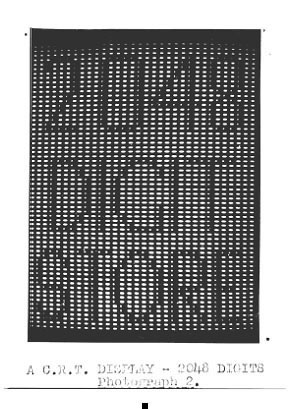
This picture is taken from Tom's report to TRE,
of December 1947, detailing the research of 1947 into a storage system for use
in computers. This culminated in the ability to store 2048 bits on a standard
radar CRT for a period of hours.
Top of page
2.The Manchester Mark 1 (Left Hand side)

Note that in comparison with the (replica) Baby, the 7th rack, at the far end, which contained the 3 CRT stores (Main Store, A and C), has been removed, and the Baby has grown at right angles underneath the windows, and then again at right angles most of the way back the other side (see photo below).
3.The Manchester Mark 1 (Wide-angle)
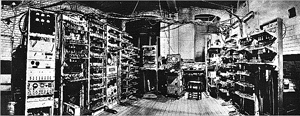
Image credit: Alec Robinson
4.Kilburn and Williams at the Manchester Mark 1 Console
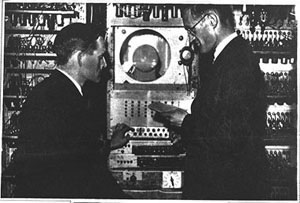
Tom is on the left, F.C. on the right. You can see the monitor CRT, propped up
on a cardboard box (faithfully duplicated in the Replica!) -- presumably they
had at one time expected to use a 12" monitor rather than a 6". Underneath is
the bank of 8 * 5 press buttons for setting ones in a word, and then various
other switches underneath, in particular for setting the page and line for
display on the monitor, and controlling the operation of the machine.
Top of page
5.The research group at work on the Manchester Mark 1
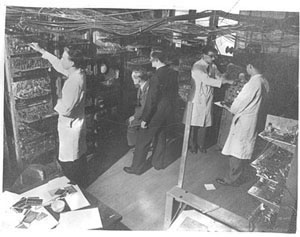
Here we see the Manchester Mark 1 Engineering team (minus Geoff Tootill) at work; left to right D.B.G. (Dai) Edwards, Prof. F.C. Williams, Tom Kilburn, A.A. (Alec) Robinson and G.E. ("Tommy") Thomas.
Top of page
6.Dai Edwards and Tommy Thomas at work on the Manchester Mark 1
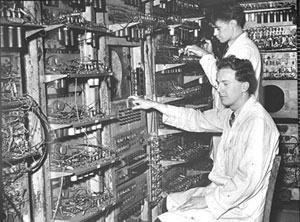
Dai is sitting and Tommy Thomas standing.
Top of page
7.Alec Robinson at work on the Manchester Mark 1
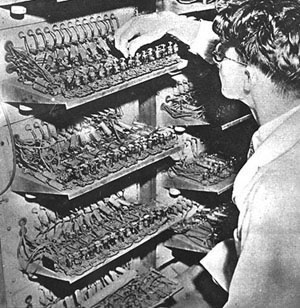
Alec Robinson started a Ph.D. project in the
summer of 1947 on an electronic multiplier. He was working for English Electric
at the time. Initially the project was kept separate from the CRT research to
avoid problems in pursuing the Ph.D. degree, but obviously as soon as the Baby
proved itself he became part of the team to produce the Manchester Mark 1 -- he
needed the computer as a test bed and the computer needed his multiplier! Later
he redesigned the multiplier for the Ferranti Mark 1.
Top of page
8.The First Program (revised) from Geoff Tootill's notebook

Geoff Tootill has kept his log book covering
the period from June 1948 to October 1948. This page shows a revised version
of the first program run on the Baby, written by Tom Kilburn. (A full annotation
of this program is given elsewhere).
Top of page
9. Freddie Williams

This photo is probably taken about 10 years later.
Top of page
10.Staff of the Electrical Engineering Department

A staff photograph of the whole Engineering department taken in 1950. The staff of the Electrical Engineering Department are shown in bold:
Back row, left to right:
J.K. Alderman, J.C. West, C.N.W. Litting, E.R. Laithwaite, D.B.G.Edwards, F.G. Edwards
Middle Row: R.K. Livesly, J. Allen, B. Standing, J.K. O'Sullivan,
J.R. Spooner, L.S. Piggott
Front Row: G.E. Thomas, H.
Gerrard, C.M. Mason, Prof. F.C. Williams, J. Higham, T. Kilburn, R. Mathieson
J.C. West worked with Professor Williams on the electric motor for the prototype drum, with its important servo-mechanism to maintain synchronisation with the refresh cycle of the main store. In 1957 he left to take up a Chair of Electrical Engineering at Queen's University, Belfast, and had a distinguished career. He was President of the I.E.E. in 1984-85, and Vice-Chancellor of Bradford University.
Eric Laithwaite had a distinguished career, being best known for his work on linear induction motors. He and Professor Williams collaborated on research into induction motors. In 1964 he left to take up the Chair of Electrical Engineering at Imperial College, London.

